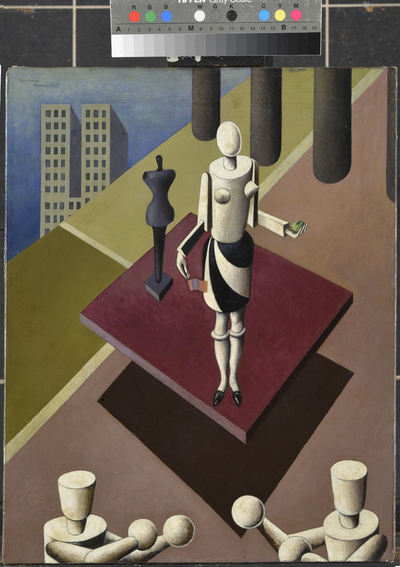Javascript must be enabled to continue!
The New Eve
View through Europeana Collections
In 1918 Sándor Bortnyik joined the circle of artists around the activist periodical titled MA. He was exiled in 1919, and came under the influence of the international Constructivist movement. Between 1922 and 1924 he lived in Weimar, where he met the artists of the Bauhaus. He painted abstract two- and three-dimensional compositions, which he subsequently populated with figures and objects. The New Adam and the New Eve are such works. In his compositions he portrays the ironically conceived ideal of the “modern” human of the 1920s. Adam is an extremely trendily dressed man who can be wound up like a clockwork machine, while Eve is a showroom dummy who can be manipulated in every direction, with the Apple of Sin in her hand. In these ironically toned paintings, the artist takes a critical swipe at the “brave new world” of the Constructivists. Reminiscent of a showroom dummy, a wind-up, clockwork figures stand in the middle of the abstract composition like puppets on a Bauhaus stage. Bortnyik took great pleasure in meticulously refining the details of the planes and geometric shapes, and the equilibrium and colour harmony of this abstract composition are delightful in their adherence to the best principles of Constructivist painting. The painter treats utopian ideals with irony, but he cannot escape them, for he too is an active participant in shaping the “new world”.
Museum of Fine Arts - Hungarian National Gallery, Budapest
Title: The New Eve
Description:
In 1918 Sándor Bortnyik joined the circle of artists around the activist periodical titled MA.
He was exiled in 1919, and came under the influence of the international Constructivist movement.
Between 1922 and 1924 he lived in Weimar, where he met the artists of the Bauhaus.
He painted abstract two- and three-dimensional compositions, which he subsequently populated with figures and objects.
The New Adam and the New Eve are such works.
In his compositions he portrays the ironically conceived ideal of the “modern” human of the 1920s.
Adam is an extremely trendily dressed man who can be wound up like a clockwork machine, while Eve is a showroom dummy who can be manipulated in every direction, with the Apple of Sin in her hand.
In these ironically toned paintings, the artist takes a critical swipe at the “brave new world” of the Constructivists.
Reminiscent of a showroom dummy, a wind-up, clockwork figures stand in the middle of the abstract composition like puppets on a Bauhaus stage.
Bortnyik took great pleasure in meticulously refining the details of the planes and geometric shapes, and the equilibrium and colour harmony of this abstract composition are delightful in their adherence to the best principles of Constructivist painting.
The painter treats utopian ideals with irony, but he cannot escape them, for he too is an active participant in shaping the “new world”.
Related Results
Angel of the Divine Presence Bringing Eve to Adam (The Creation of Eve: "And She Shall be Called Woman) (recto); Sketch for the same (verso)
Angel of the Divine Presence Bringing Eve to Adam (The Creation of Eve: "And She Shall be Called Woman) (recto); Sketch for the same (verso)
Watercolor pen and black ink over graphite...
Adam and Eve Making Garments of Leaves; God Admonishing Adam and Eve for their Transgression (one of a set of three)
Adam and Eve Making Garments of Leaves; God Admonishing Adam and Eve for their Transgression (one of a set of three)
Canvas worked with wool silk and metal thread; chain split tent and straight stitches; appliqué of woven silk textiles; metal thread braid...
Eve Sonneman, Gold Balloons, New Year's Eve, Metropolitan Club, New York (2018)
Eve Sonneman, Gold Balloons, New Year's Eve, Metropolitan Club, New York (2018)
Digital photograph on glossy Japanese paper, ed. 5, 20 × 30 in...




